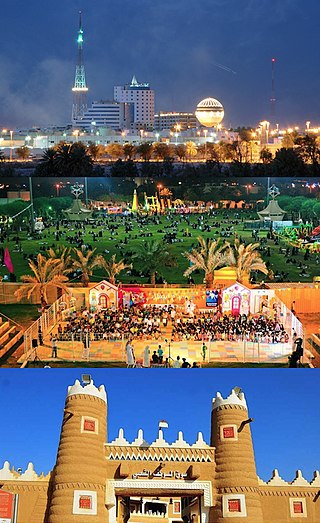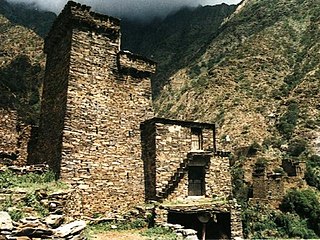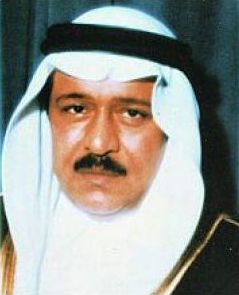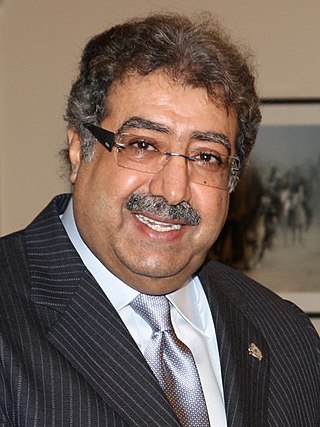
Transport in Saudi Arabia is facilitated through a relatively young system of roads, railways and seaways. Most of the network started construction after the discovery of oil in the Eastern Province in 1952, with the notable exception of Highway 40, which was built to connect the capital Riyadh to the economically productive Eastern Province, and later to the Islamic holy city of Mecca and the port city of Jeddah. With the economic growth of the 1970s, the Kingdom of Saudi Arabia has initiated many infrastructure development projects across the country, and the extensive development of the transportation network has followed suit in support of various economic developments.

Riyadh, formerly known as Hajr al-Yamamah, is the capital and largest city of Saudi Arabia. It is also the capital of the Riyadh Province and the centre of the Riyadh Governorate.

Sultan bin Abdulaziz Al Saud, called Sultan the Good in Saudi Arabia, was the Saudi defense minister from 1963 to 2011 and the Crown Prince of Saudi Arabia from 2005 to 2011.

Al-Jawf Province, also spelled Al-Jouf, is one of the provinces of Saudi Arabia, located in the north of the country, partially bordered by Jordan to the west. It is one of the earliest inhabited regions of Arabian Peninsula, with evidence of human habitation dating back to the Stone Age and the Acheulean tool culture. Human settlement continued unbroken throughout the Copper Age, a period that saw the kingdom of Qidar fight against the Assyrian state for its independence. It is also in this period that references to Arabs first appear in historical texts. A Christian kingdom later emerged under the rule of the Bani Kalb tribe and survived until the arrival of Islam and the Islamic conquest of Al-Jawf. Following the region's Islamization it fell under the control of the Tayy tribe. Al-Jawf was incorporated into the third Saudi state at the time of its formation in 1932. In the 20th century the region was a site of conflict between the Al-Rashid family and the Al-Shaalan family, though it eventually came under the rule of King Abdulaziz bin Abdul Rahman Al Saud.

The Qassim Province, also known as the Qassim Region, is one of the 13 provinces of Saudi Arabia. Located at the heart of the country near the geographic center of the Arabian Peninsula, it has a population of 1,370,727 and an area of 58,046 km². It is known to be the "alimental basket" of the country, for its agricultural assets.

Sultan bin Salman Al Saud is a Saudi prince and former Royal Saudi Air Force pilot who flew aboard the American STS-51-G Space Shuttle mission as a payload specialist. He is the first member of a royal family to fly in space, the first Arab to fly in space, and the first Muslim to fly in space, as well as the youngest person ever to fly on the Space Shuttle. On 27 December 2018, he was appointed as chairman of the Board of Directors of the Saudi Space Commission at the rank of minister. He is the eldest surviving son of King Salman.

The Masmak Fort, also called the Masmak Fortress or Masmak Palace, is a clay and mudbrick fort in the al-Dirah neighborhood of Riyadh, Saudi Arabia, located in close proximity to the al-Hukm Palace in the Qasr al-Hukm District. Built in 1865 for prince 'Abdurrahman ibn Sulaiman AlDabaan under the Emirate of Jabal Shammar, The fortress played an integral role in the Unification of Saudi Arabia, with the Battle of Riyadh, one of the most important conflicts of the Saudi unification, taking place in the fort. Since 1995, the fortress has been converted into a museum showcasing one of the most important landmarks of Saudi heritage.

Articles related to Saudi Arabia include:
Abdul Majeed bin Abdulaziz Al Saud was a Saudi Arabian politician and businessman who served successively as the governor of the Tabuk, Medina, and Mecca provinces between 1980 and 2007. A prominent member of the House of Saud, Abdul Majeed was seen as a close ally of King Abdullah, but was also regarded as a long-time ally of the Sudairi Seven.

Saudi Arabia is the second biggest tourist destination in the Middle East with over 16 million visiting in 2017. Although most tourism in Saudi Arabia still largely involves religious pilgrimages, there is growth in the leisure tourism sector. As the tourism sector has been largely boosted lately, the sector is expected to be the white oil for Saudi Arabia. This is proved as tourism sector is expected to generate $25 billion in 2019. Potential tourist areas include the Hijaz and Sarawat Mountains, Red Sea diving and a number of ancient ruins.

The Ministry of Foreign Affairs is the ministry responsible for handling the Kingdom of Saudi Arabia's external relations. The ministry oversees "political, cultural and financial international relations" and monitors the Kingdom's diplomatic relations. It was created in 1930 by a royal decree issued by King Abdulaziz Al Saud, being the first ministerial body created by the King.

Muhammed bin Saud Al Saud was a Saudi royal and politician. He was a son of King Saud. He served as the Saudi Arabian minister of defense from 1960 to 1962 during his father's reign. Later Prince Muhammed was the governor of Al Bahah Province from 1987 to 2010.

Faisal bin Abdullah Al Saud is a retired Saudi Arabian politician and businessman who served as the Saudi Arabian minister of education from 2009 to 2013 in the administration of King Abdullah, his maternal uncle and father-in-law. He is a member of the House of Saud.
Nasser bin Abdulaziz Al Saud was a Saudi Arabian businessman who served as the governor of Riyadh Province from 1938 to 1951. He was a member of the House of Saud.
The following is a Gregorian timeline of the history for the city of Riyadh, Saudi Arabia.

The Ministry of Tourism, before 2020 as the Saudi Commission for Tourism and National Heritage (SCTH), till 2015 as the Saudi Commission for Tourism and Antiquities (SCTA) and prior to 2008 as the Supreme Commission for Tourism (SCT), is a government ministry in Saudi Arabia that is concerned with the tourism sector of the country. Established in the year 2000 through a royal decree by King Fahd, it was transformed into a ministry in 2020.
Below are Museums in Riyadh. The Riyadh region in Saudi Arabia is characterized by having a massive number of historical and heritage monuments and museums, which represent the successive civilizations that left these traces on the area.













